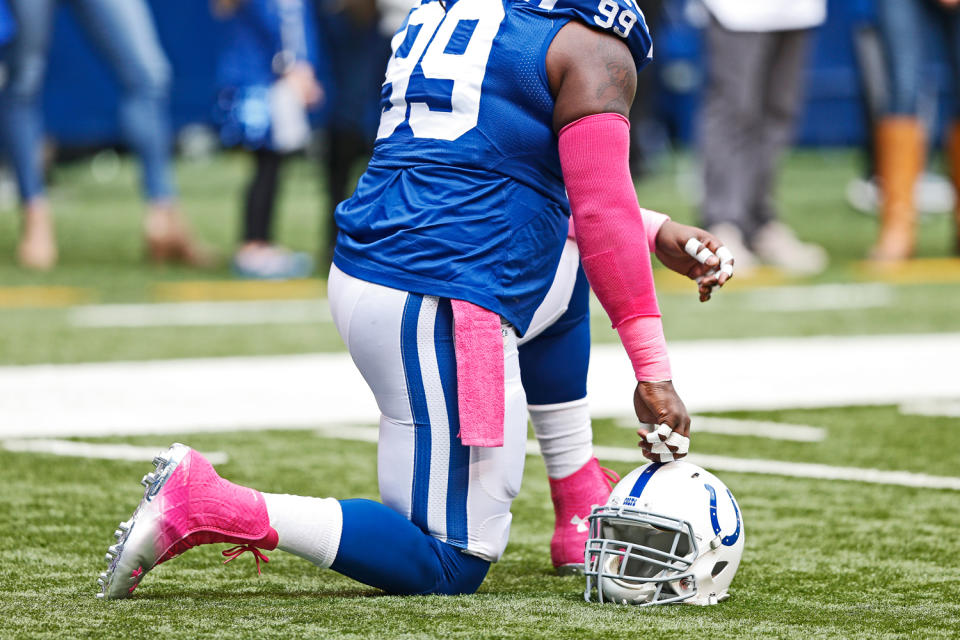Super Bowl Sunday is also World Cancer Day. Here's how the NFL is doing its part

While millions of eager football fans across the country are ready to watch the New England Patriots take on the Philadelphia Eagles in Super Bowl LII on Sunday, Feb. 4, that date also happens to have an additional significance: It’s World Cancer Day.
And unlike any number of made-up holidays, like “Talk Like a Pirate Day,” the nonprofit awareness organization Union for International Cancer Control is behind the day, which is recognized by the United Nations.
World Cancer Day and the Super Bowl make for a fitting overlap, considering the work the National Football League does to raise money and awareness in the fight against cancer. The League’s Crucial Catch Initiative, a partnership with the American Cancer Society to promote screening and education around cancer, is nine years old and has so far raised $18 million for the ACS.
Anna Isaacson, the NFL’s senior vice president of social responsibility, says the national initiative was born out of the work local league teams and high school sports were doing on their own to fundraise for breast cancer (think: pink socks and jerseys under Friday night lights). About a year and a half ago, Isaacson tells Yahoo Lifestyle, the NFL and ACS started to think about how they could mimic their success with breast cancer funding to branch out into other diseases.

“We thought, why not take what we’ve done for breast cancer and expand it to other forms?” Isaacson says. Soon after, Crucial Catch events started to educate attendees about colorectal and cervical cancers, as well as the human papilloma virus. “Yes, it’s a lofty goal to not only have an impact on screening rates and prevention and detection for breast cancer, but for other diseases too.”
In addition to holding fundraising and educational events, the NFL has what it calls its “Defender Tool,” an interactive digital tool that anyone can use to determine their personalized cancer risk. The league also provides a $75,000 grant over 18 months to a federally qualified health center in each of its 32 markets across the country.
“They’re right at the heart of the most underserved communities, making people feel like it’s OK to go and get screened,” Sharon Byers, chief development and marketing officer for the American Cancer Society, says of the NFL’s health center grants. “They’re difficult markets, because in those communities, it may be hard, culturally, for people to go get screened. They’re afraid, and it’s a big challenge for us.”

In order to be a federally qualified health center (of which there are roughly 1,400 across the country that serve 25 million people a year), a health center must cater to an underserved area or population and receive federal funding, among other requirements outlined by the Health Resources and Services Administration.
One such place is in North Philadelphia, Pa.: the Maria de los Santos Health Center, which qualified for the NFL’s grant in 2017. The facility has so far used the NFL grant to “overcome some of the barriers to cancer screening, including cost of the screening tests, transportation to and from tests, and the costs of additional diagnostic testing following abnormal screenings,” Julia DeJoseph, a senior medical director there, tells Yahoo Lifestyle.
DeJoseph admits that as helpful as any funding is, always, the NFL’s grant came at a particularly important time.
For example, the health center’s umbrella system of the Delaware Valley Community Health saw 42,848 patients in 2016 — 21 percent of which are uninsured, 57 percent of which rely on Medicaid, and 69 percent of which are Hispanic or Latino, including many of whom are Puerto Rican. And that breakdown, which mirrors the population of North Philadelphia at large, is only expected to increase, considering the displacement of entire communities after Hurricane Maria. (According to one report, 27,000 Puerto Ricans could move to Pennsylvania within the year.)
Of course, the more people who need help, the more challenging DeJoseph’s job can be.
“If someone has an abnormal screening, the grant would cover that, but that’s not the end of their story,” she explains. “Let’s say they had a fit test, then they will need a colonoscopy. They’d then need a biopsy, and if that’s positive, they may need surgery. If it’s more severe, they may need chemotherapy or radiation. That $75,000 would cover that patient’s anesthesia and biopsy, so I can spend $75,000 in one day on a single patient and still not have even cured, let alone diagnosed, their cancer.”
In addition to the pressures faced at the medical facility due to an influx of people fleeing natural disasters, the Maria de los Santos Health Center also faces the possibility that its federal funding will end under the current administration.

As it stands today, federally qualified health centers receive $5.1 billion in federal funding each year, according to Bloomberg. But, it reports, “most of that money dried up on Sept. 30 and a highly polarized Congress appears to be in no rush to approve a long-term extension,” with a Band-Aid of funding set to end in March.
The funds allocated to those health centers were established under the 2010 Affordable Care Act, but due to the congressional impasse, people like DeJoseph worry about what it will mean for patients who still need care and screenings but can’t afford them on their own.
That’s why, despite the allocation challenges, the grant money is vital — as is the American Cancer Society, she says, as it “has helped us continue to look for the answers.”
The NFL is there to help lead in the offensive too.

Read more from Yahoo Style + Beauty:
How Larry Nassar’s victims are healing thanks to cathartic statements
Why Adriana Lima and Emily Ratajkowski can both be feminists, no matter how much skin they show
Follow us on Instagram, Facebook, and Pinterest for nonstop inspiration delivered fresh to your feed, every day. For Twitter updates, follow @YahooLifestyle.

